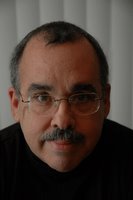Roberto Sierra's Missa Latina Premiered
 Thursday was another world premiere day for the audience at the Kennedy Center. The National Symphony Orchestra under Leonard Slatkin, the Choral Arts Society of Washington (Norman Scribner), and soloists Heidi Grant Murphy and Nathaniel Webster presented Roberto Sierra’s Missa Latina (“Pro Pax”) that had been commissioned by the performing forces. A work based on the Latin Mass as Mr. Sierra remembers it from childhood, a plea for peace (hence “Pro Pax”), it is also a showcase for Sierra’s Hispanic background, “which,” he is quoted in the notes by Richard Freed, “comes across through the fabric of my musical language.” That might just be a bit of an understatement, as it turned out. It’s a Catholic work alright, set to the text of the traditional Latin Mass with the Kyrie (Hello, Carmina Burana!), Gloria, Credo (ever-lasting), Sanctus, and Agnus Dei as well as an Introitus and Offertorium (wild and smashing), but it has more than a shade of Caribbean or South American flair to it; it carries that heritage most prominently on its sleeve.
Thursday was another world premiere day for the audience at the Kennedy Center. The National Symphony Orchestra under Leonard Slatkin, the Choral Arts Society of Washington (Norman Scribner), and soloists Heidi Grant Murphy and Nathaniel Webster presented Roberto Sierra’s Missa Latina (“Pro Pax”) that had been commissioned by the performing forces. A work based on the Latin Mass as Mr. Sierra remembers it from childhood, a plea for peace (hence “Pro Pax”), it is also a showcase for Sierra’s Hispanic background, “which,” he is quoted in the notes by Richard Freed, “comes across through the fabric of my musical language.” That might just be a bit of an understatement, as it turned out. It’s a Catholic work alright, set to the text of the traditional Latin Mass with the Kyrie (Hello, Carmina Burana!), Gloria, Credo (ever-lasting), Sanctus, and Agnus Dei as well as an Introitus and Offertorium (wild and smashing), but it has more than a shade of Caribbean or South American flair to it; it carries that heritage most prominently on its sleeve.
Tim Page, The Joyful Noise Of 'Missa Latina' (Washington Post, February 3) Charles T. Downey, Díaz Trio at the Library of Congress (world premiere of Roberto Sierra's Kandinsky, February 14, 2004) |
 I admit to seeing a connection between text and the added Latin spice, but while Mr. Sierra’s God might shake the Maracas and bang the Bongos, I feel more like Robert R. Reilly (he, precognizant, stayed away), who wrote (albeit about Golijov’s Passion) that “I cannot salsa down the via dolorosa.” The image fits perfectly, because the percussion section’s contributions often felt like a mime dancing in front of the orchestra, hips swinging ostentatiously, pointing out the underlying rhythm in painfully obvious ways. I think that the work might have truly impressed me, were Sierra to have cut the snare drum, bass drum, Cuban timbales, bongos, congas, tom toms, glockenspiel, xylophone, vibraphone, marimba, tam-tam, gong, crash cymbals, suspended cymbals, hi-hat, cencerros, triangle, maracas, claves, güiro, vibra-slap, and cabaza (all present) out of the score. What are obstructions to and detractions from the music may be highlights to someone else… but there was, despite much beautiful music, another quibble I had. The constant regular musical eruptions and swooping mini-climaxes that lacked – unlike in Bruckner – the grand design of overarching ideas and structure or – as in Mahler – the cumulative power of neurotic outbursts left one with the feeling of impotence, after a while.
I admit to seeing a connection between text and the added Latin spice, but while Mr. Sierra’s God might shake the Maracas and bang the Bongos, I feel more like Robert R. Reilly (he, precognizant, stayed away), who wrote (albeit about Golijov’s Passion) that “I cannot salsa down the via dolorosa.” The image fits perfectly, because the percussion section’s contributions often felt like a mime dancing in front of the orchestra, hips swinging ostentatiously, pointing out the underlying rhythm in painfully obvious ways. I think that the work might have truly impressed me, were Sierra to have cut the snare drum, bass drum, Cuban timbales, bongos, congas, tom toms, glockenspiel, xylophone, vibraphone, marimba, tam-tam, gong, crash cymbals, suspended cymbals, hi-hat, cencerros, triangle, maracas, claves, güiro, vibra-slap, and cabaza (all present) out of the score. What are obstructions to and detractions from the music may be highlights to someone else… but there was, despite much beautiful music, another quibble I had. The constant regular musical eruptions and swooping mini-climaxes that lacked – unlike in Bruckner – the grand design of overarching ideas and structure or – as in Mahler – the cumulative power of neurotic outbursts left one with the feeling of impotence, after a while.Leonard Slatkin conducted with visible enthusiasm and engagement, evidently believing in the work (as he should, of course) and enjoying the many theatrical entries of various loud instrument groups. In the grand final gesture – attended by the trademark ‘Slatkin-hop’ – his baton touched his back before he flung it orchestra-wards one last time. Heidi Grant Murphy (appearing in an intriguing, steel/powder-blue dress) is one of the finest lighter voices of her generation. Her always agile voice navigated through the whole affair with ease and soft and hushed tones were particularly impressive. She was seconded by the young baritone Nathaniel Webster, who offered a performance no lesser than that of his more seasoned and famous colleague.
Repeat performances will take place Friday and Saturday at 8PM.





















































